
Weapons of the Hungarian Revolution
A great deal has been written about the Hungarian Revolution of 1956; about it’s initial successes and ultimate failure, leading to the killings, execution, imprisonment, and exile of hundreds of thousands of Hungarians who were fighting to free their country from Soviet domination.
Less well documented are the revolutionaries weapons. Revolutionaries around the world use whatever weapons they can beg, borrow, or steal, and the Hungarian revolutionaries were no different. They primarily used captured weapons from the Hungarian Army; in 1956, the Army was in a period of transition from German to Soviet weapons, and the revolutionaries were able to use both types against the invading Soviets.
German Weapons:
The Hungarians had joined the Axis powers in 1940. The Hungarian fascist Arrow Cross Party, which took power in 1935, was more of the more radical Axis government, passing anti-semitic laws and seeking to expand Hungary into the sovereign territory of its neighbors. During World War II the Hungarian military fought against the Allies, declaring war against the Soviet Union on 27 June 1941, five days after Adolph Hitler launched Operation Barbarossa, his own invasion. As such, the Hungarian arms industry was aligned with that of the Nazi War machine. There were so many weapons manufactured, that even after WWII, the Hungarian military continued to use them.
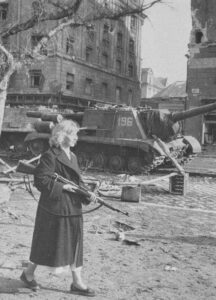
Mannlicher M1943 Infantry Rifle – this basic infantry weapon, chambered to fire the 7.92x57mm Mauser cartridge, was adopted to conform to Nazi standards.
WALAM Pistol – modeled on the Nazi Walter PP and PPK, the WALAM was actually manufactured in 1948, after the fall of the Arrow Cross government, but before weapon manufacturing could be converted to Soviet standards.
Schwarzlose Heavy Machine Gun Model 07/12 – this WWI-era machine gun was unique, in that it used a special blowback suppression system which allowed it to fire larger rifle cartridges than other machine-guns of the time. Initially manufactured in Germany, t was popular with a variety of European Armies during WWI and the late colonial era. It most famously served as the Nazi second-line defense in the Germans desperate efforts to stop the Allied advances in 1945. The Schwaszlose required a three-man crew – a commander, a gunner, and a loader.
Soviet Weapons:
After the fall of the Arrow Cross Party and the domination of Hungary by the Soviet Union, arms production was shifted to weapons compatible with the Soviet logistics system.
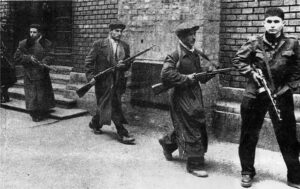
Mosin-Nagant 1944/56 and Nosin-Nagant 1948 – basic infantry riles, superficially similar to the Mannlicher M1943, but using more modern Soviet 7.62x54mm ammunition. Of interest, although the revolution only lasted from 23 October until 10 November 1956, some Hungarians took the time to re-stamp and re-mark their weapons to show they were part of the revolutionary army. The modified rifles were marked “FR”, presumable for Forradalmi Regiment (Revolutionary Army), and a serial number.
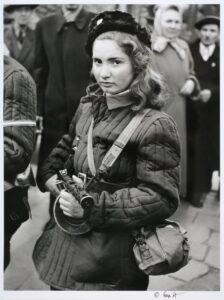
PPSh41 (Model 48) Submachine Gun – the submachine gun that won WWII, with its distinctive black cylindrical magazine and brown wooden stock was a staple of the revolutionaries. Stocks had been seized from Hungarian Police Stations and used to fight the Soviets.
AK-47/AK-55 Assault Rifle – the revolutionaries seized AK-47 Soviet assault rifles and the Hungarian AK-55 copies. The first revolutionary photographed with an AK-47 was József Tibor Fejes. Fejes was executed after the execution failed. He was identified by his photographs in the news media reporting on the revolution
Tokerov TT Model 48 pistol – A copy of the Soviet Tula Tokerov TT33, this was the basic Soviet military and police firearm used during the Hungarian revolution era. The Tokerov pistols of the time were distinctive because they lacked a thumb safety. The weapon was also used by the Secret Police of several Soviet-affiliated countries for executions.
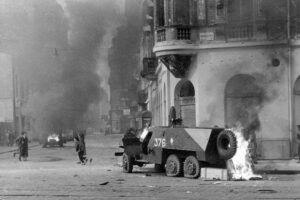
BTR-152 Combat Vehicle – Revolutionaries seized what armored vehicles they could, but Soviet airstrikes during the 3 – 4 November 1956 would have destroyed these vehicles immediately. The Bronetransporter (BTR)-152 was the first Soviet Armored Personnel Carrier (APC) and was designed to carry infantry accompanying tank assaults. It was thin-skinned and mainly designed to protect from machine-gun fire, and not aircraft or tank guns.
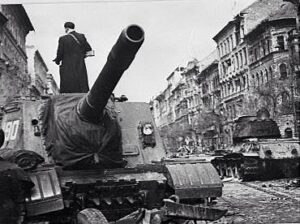
ISU-152 – Unlike the BTR-152, the ISU-152 was a massive self-propelled anti-tank gun made to take out German WWII heavy tanks like the Tiger and Panther. It had 3 roles, assault gun to destroy enemy infantry positions, tank destroyer against enemy armor, and mobile artillery to support an attack. Unfortunately, even these monstrous armored vehicles would not have stood much of a chance against Soviet aviation.
The Hungarian revolutionaries would be remembered mostly for their heroic and first stand against Soviet totalitarianism. Although they were ultimately defeated, their sacrifice gave hope to many people trapped behind the Iron Curtain.
- November 1, 2020
- Hungary
